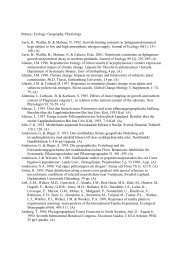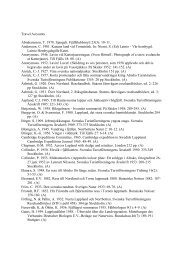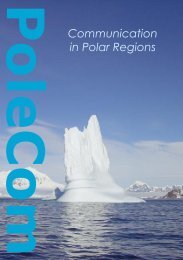Ladda ner årsbok 2008 (6,5 MB) - Polarforskningssekretariatet
Ladda ner årsbok 2008 (6,5 MB) - Polarforskningssekretariatet
Ladda ner årsbok 2008 (6,5 MB) - Polarforskningssekretariatet
Create successful ePaper yourself
Turn your PDF publications into a flip-book with our unique Google optimized e-Paper software.
arctic sweden Principal<br />
Research projects in the Swedish mountain<br />
range have come to the fore as a result of<br />
activities in connection with the International<br />
Polar Year 2007–<strong>2008</strong> (IPY). Previously,<br />
the Swedish Polar Research Secretariat has<br />
not funded fieldwork in Sweden, but the<br />
focus of the IPY has provided reasons for<br />
it to do so. One reason is the fact that the<br />
Swedish mountain range lies within the<br />
area defined internationally as the Arctic,<br />
while another important factor is the IPY’s<br />
focus on environmental and climatic factors,<br />
which will henceforth put heavier demands<br />
on each country to maintain long-term<br />
measurement series at their own research<br />
platforms. The research projects conducted<br />
under the auspices of Arctic Sweden have been<br />
interdisciplinary, and have primarily been<br />
concerned with climate changes, both natural<br />
and anthropogenic (i.e., those attributable to<br />
human factors). These research activities have<br />
been carried out in the Swedish mountain<br />
range, from Härjedalen in the south to<br />
northernmost Lapland, mainly in July and<br />
August of <strong>2008</strong>.<br />
theme 1. Glacier-climate interactions<br />
Present climate change severely affects Swedish<br />
glaciers. Exactly 100 years prior to the ongoing<br />
International Polar Year 2007–<strong>2008</strong> (IPY) the<br />
first systematic survey of Swedish glaciers was<br />
made and published by the Swedish Geological<br />
Survey. Using satellite images covering Sweden,<br />
270 glaciers have been identified. Monitoring<br />
of the response of Swedish glaciers to climate<br />
changes is carried out by Tarfala Research<br />
Station (www.tarfala.su.se).<br />
The definition of a glacier when it is building<br />
up requires that it should be in motion. The<br />
ice has to be more than 30 metre thick for<br />
ice deformation to occur which allows for<br />
movement. Many of the smaller glaciers are<br />
probably close to being inactive although this<br />
is difficult to gauge without detailed depth<br />
measurements. During Arctic Sweden we<br />
focussed on the glaciers that are still large and<br />
active. This is because the potential increase in<br />
melt of these glaciers will increase discharge in<br />
the rivers and will contribute to the increase in<br />
sea level. We therefore decided to make detailed<br />
field surveys of a number of reference glaciers<br />
located along the mountain range from Helags<br />
to Abisko. During the campaign in August we<br />
focussed mainly on the glaciers located in the<br />
inaccessible Sarek mountains. With permission<br />
from the local government we used helicopters<br />
to access the Sarek glaciers during two weeks in<br />
August. We ge<strong>ner</strong>ally needed a day per glacier<br />
when we measured the snout positions of the<br />
Mikka, Pårte, Ruopsok, Souttas, Rhuotes and<br />
Vartas glaciers. We also measured the extent<br />
of Hyllglaciären and the front position of<br />
Salajekna, the largest glacier in Sweden.<br />
Before the summer we had digitised the old<br />
Figure 1<br />
The scientist measured the glaciers<br />
that are still large and active. Salajekna<br />
is the largest glacier in Sweden and is<br />
located in the Sulitelma Massif.<br />
Photo: Gunhild Rosqvist<br />
investigators<br />
Theme 1<br />
Per holmlund<br />
gunhild Rosqvist<br />
Department of Physical Geography<br />
and Quaternary Geology<br />
Stockholm University<br />
Theme 2<br />
Anders Angerbjörn<br />
Department of Zoology<br />
Stockholm University<br />
göran Ericsson<br />
Department of Wildlife, Fish and<br />
Environmental Studies<br />
Swedish University of Agricultural<br />
Sciences, Umeå<br />
Theme 3<br />
Terry Callaghan<br />
Christer Jonasson<br />
Abisko Scientific Research Station<br />
Thomas B. larsson<br />
Department of History, Philosophy<br />
and Religion, Umeå University<br />
åRSBoK YEARBooK <strong>2008</strong><br />
43








